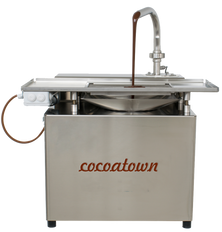Best Valentine's Day chocolate: Bean-to-bar artisan brands
Source: CHICAGO TRIBUNE | FEB 08, 2016 | By LAURA LEVY SHATKIN | Best Valentine's Day chocolate: Bean-to-bar artisan brands
In the heart of historic downtown Woodstock sits the quaint Victorian storefront coffee shop turned chocolate factory Ethereal Confections. A glance at the hand-carved sign and a seductive whiff of the sweet aroma makes it clear that something special is going on inside.
It's the home of a bean-to-bar chocolate shop launched four years ago by foodies and siblings Mary and Michael Ervin, in collaboration with Sara Miller.
"We took a few confection-making classes and read books but mostly learned by trial and error," says Miller. "There's nobody out there, that we know of, not even a culinary school, that teaches the bean-to-bar process."
Ethereal Confections is just one of a few dozen American confectioners trying their hand at the labor-intensive craft. Bean-to-bar chocolate means that the chocolatier oversees every step of the chocolate-making process, from purchasing the fermented cacao beans to roasting, grinding and tempering. This sharply contrasts with the typical process of melting purchased chocolate disc or blocks to create molded chocolates. Chocolate for Valentines Day might seem routine but passing along the labor of love inherent in these craft chocolates makes the gift more than just delicious and decadent.
American chocolate artisans now span from Seattle and Central Point, Ore., down to Berkeley, Calif., and across the U.S. to Asheville, N.C., and Brooklyn, N.Y. While San Francisco-based Scharffen Berger was the first domestic bean-to-bar chocolatier in 1997, when Hershey's acquired them in 2005, the broader adoption of bean-to-bar chocolate-making stalled. While Seattle's Theo Chocolates emerged soon thereafter, they did so quietly at first. Today, the craft is a full swing movement, likened to coffee, cheese and beer craft trends of the past decades.
Even scandal has brought focus on the movement. Mast Brothers, a high-profile Brooklyn firm that staked its claim and high prices on bean-to-bar authenticity, was accused in an investigation by food blog DallasFood.org of melting purchased chocolate in the early years of the company. Mast made a partial admission to the New York Times, after initially denying allegations, and now claims to make its chocolate from scratch. Yet the scandal underscores the fact that claims of bean-to-bar authenticity are not regulated, perhaps creating an element of skepticism. Here's how artisan makers do it.
Accessing cacao beans
The first challenge for the choco-artisan is to find a small-scale American cacao bean broker, of which there are few. Ethereal Confections opts to buy only Central and South American beans in an effort to support more ethical farming and economics. "We didn't feel comfortable purchasing products from Africa," says Michael Ervin, because they feel human rights, growing conditions and the economics are subpar. Their brokers buy from farmer co-ops, which they hope assures fairness and better growing practices.
Blair Potts, of Potts Chocolate in Charlotte, says he also tries hard to source beans that are fairtrade and organic. "The problem with those labels," he says, "is that with a commodity like cacao (at this point in time), it is very easy to cheat." Oversight may be coming soon as the industry blossoms, the demand grows and accountability pays off. But it's yet to arrive.
Hand sorting and roasting
Once the 150-pound burlap sacks of beans arrive in Woodstock, they're hand-sorted to omit debris, such as small branches or stones. Several pounds of beans are roasted at a time in convection ovens. "Part of the magic is roasting them our way," Miller says. "Longer roasting time brings out deeper, more bitter flavors, similar to dark roast coffee, whereas shorter roasting highlights the fruity acidic elements," she says, elusively, without revealing precise methods. The beans' origin also impacts roasting, and each batch is slightly different. Formulas don't quite work here.
Jeff Shepherd, of Lillie Belle Farms, started out using a coffee roaster. He guessed on roasting times, burned a few batches then tried again and again until he got it right. "Low and slow is generally the rule," Sheppard says. The roasting breaks down the cell walls to release flavor and oils. It's a crucial step but without widely accepted standards in this nascent industry, each maker figures it out on his or her own.
Winnowing
Winnowing cracks the protective husk, loosening the beans. Miller and Ervin found a makeshift contraption by Chocolate Alchemy, one of the few chocolate-making equipment and bean suppliers, for small scale producers. "Beans go through a metal funnel, get crushed in an attached juicer, releasing the lighter husks that are vacuumed out by a rigged-up shop vac," says Miller. The remaining cracked beans, now called nibs, fall into a bucket. It's a bit clumsy but it does the trick.

Grinding into liquor:
The nibs are 50 percent cocoa butter. Grinding them in an electric CocoaTown machine generates heat by the friction of two large rotating granite wheels. Within a few hours, there's enough heat to extract the natural creamy cocoa butter, transforming the nibs into a paste. The tension of the grinder is then reduced, sugar and cocoa butter are added and "conching," or stirring, continues for up to three days to release volatile chemicals, eliminate harsh or acidic flavors and yield a silky, rich finished product called "liquor." The chocolate liquor is transferred into 28-inch-by-12-inch hotel pans to solidify for future use. Larger manufacturers typically also add vanilla, lecithin and milk powder to create a consistent and unique flavor profile, which many artisans argue detracts from the true chocolate flavor.
Read Full & original article here:
https://www.chicagotribune.com/dining/ct-bean-to-bar-chocolate-food-0203-20160205-story.html

